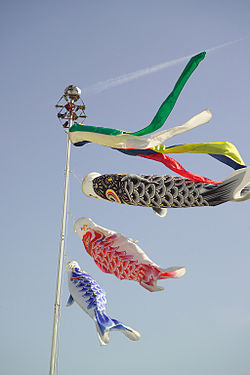Let me tell you about Japanese festival"Tangonozekku(The boy's festival)"
The day was originally called Tango no Sekku,
The festival is still celebrated in China, Taiwan, Hong Kong and Macau as the Duanwu Festival or Tuen Ng Festival (Cantonese), in Korea as the Dano Festival, and Vietnam as the Tết Đoan Ngọ on the traditional lunar calendar date.
Sekku means a season's festival (there are five sekku per year).
Tan means "edge" or "first" and go means "noon".
Although it is not known precisely when this day started to be celebrated,
Until recently, Tango no Sekku was known as Boys' Day (also known as Feast of Banners)
while Girls' Day (Hinamatsuri) was celebrated on March 3.
In 1948, the government decreed this day to be a national holiday to celebrate the happiness of all children and to express gratitude toward mothers.
It was renamed Kodomo no Hi.
Before this day, families raise the carp-shaped koinobori flags (carp because of the Chinese legend that a carp that swims upstream becomes a dragon, and the way the flags blow in the wind looks like they are swimming), one for each boy (or child), display a Kintarō doll usually riding on a large carp, and the traditional Japanese military helmet, kabuto. Kintarō and the kabuto are symbols of a strong and healthy boy.
when he was a child.
and played with animals in the mountains when he was a young boy.
Mochi rice cakes wrapped in kashiwa (oak) leaves—kashiwa-mochi (just like regular mochi, but is also filled with red beans jam) and chimaki (a kind of "sweet rice paste", wrapped in an iris or bamboo leaf)—are traditionally served on this day.
Koinobori
Kintarou(The middle person)
Kabuto
We can make Kabuto with Origami!!:)
Kashiwamochi
Chimaki
I have one older brother so like Hinamatsuri,
the familiy who has boy have Kabuto at home!!
I have Kabuto at home too!!:)
Shobuyu
And we enter furo which shobu is in!!:)
About shobuyu
The Japanese steep the leaves in hot water and enjoy the fragrant
Shobu-yu (iris hot-bath) because of the traditional belief that the iris bath is
a miraculous prophylactic against all kinds of sickness.
Many public bath
houses, particularly in the districts where the people are less affected
by
western influence and are accustomed to taking hot baths in the morning,
open
their doors early in the morning on May 4 and 5.
There are lot of things to do in this day too!!:)







No comments:
Post a Comment